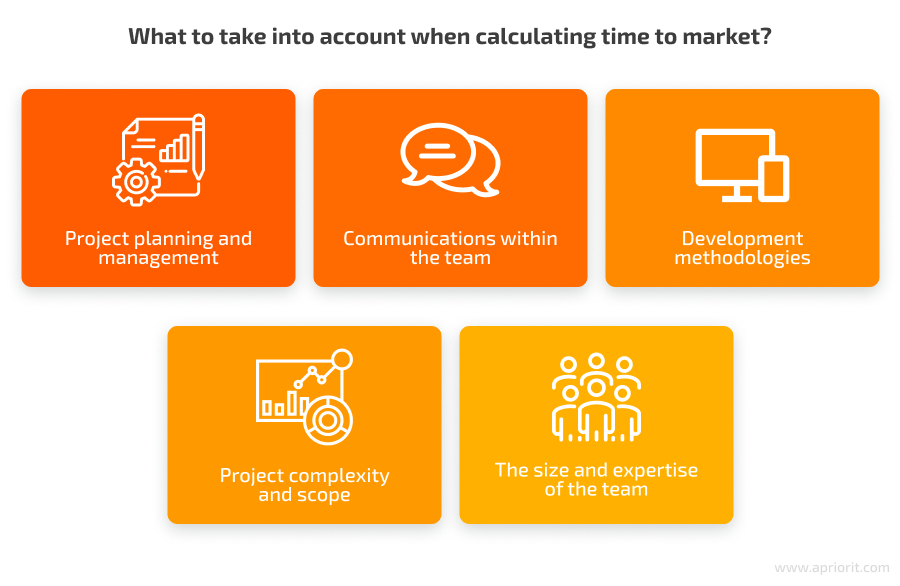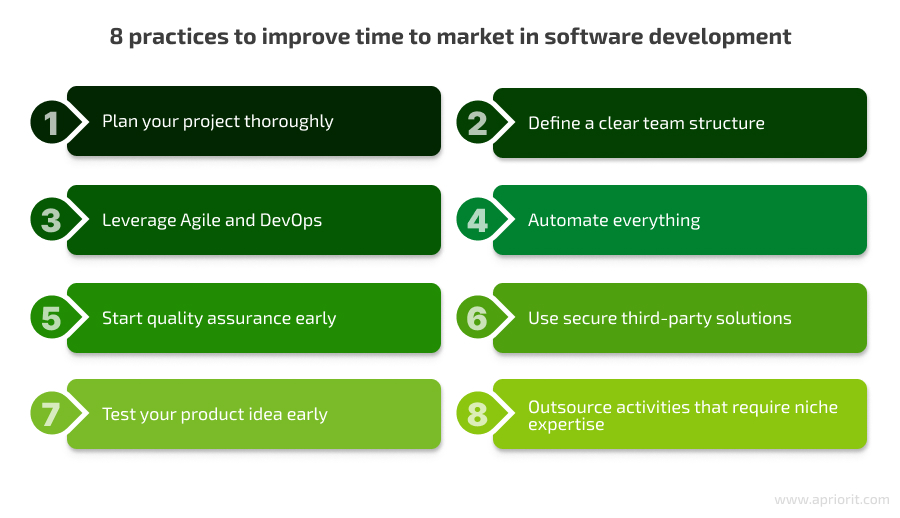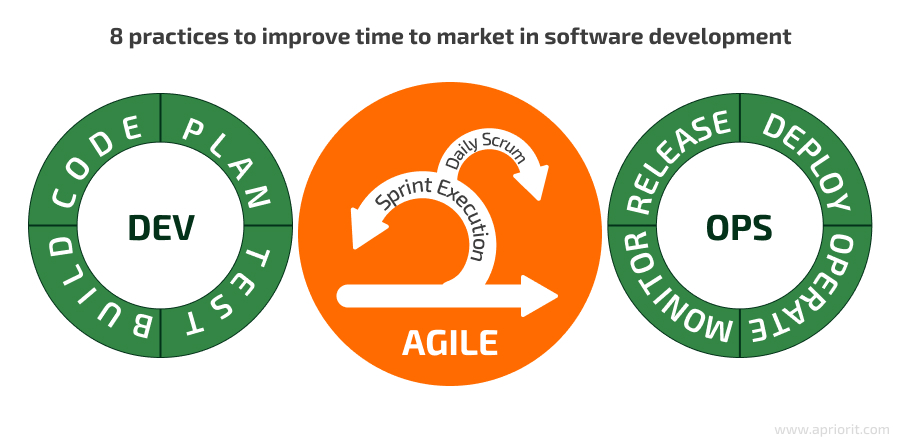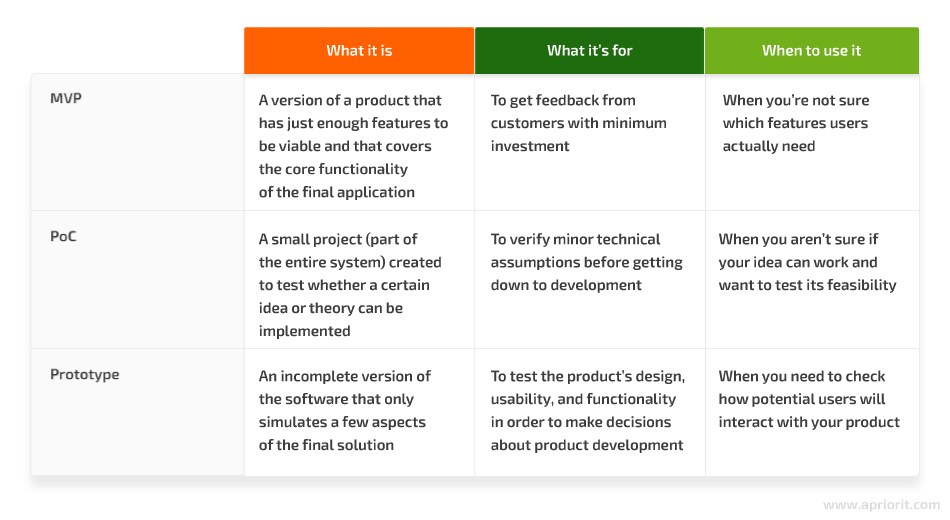In a world where new products appear every day and competition is becoming fiercer and fiercer, time is the most valuable resource. Every week of delay results in lost potential profits and a smaller market share. While companies strive to reduce the time to market (TTM) for their next product, it’s important to do it without compromising on software quality and security.
In this article, we discuss the meaning of time to market and talk about all the ways of releasing a secure and reliable application as fast as possible. You’ll find out how time to market is formed, which development factors impact TTM the most, and which practices can help speed up the software release.
This article will be useful for product owners looking for ways to shorten the time to market for their applications.
What is time to market and why is it important?
Time to market is a software development metric that measures the time between forming the initial concept of a product and its release. Companies can calculate TTM differently by, for example, starting the clock from the emergence of a product idea or from the start of development. TTM also depends on what you consider product release: delivery of the first iteration or release of the final product version.
To achieve your business goals, you need to develop a quality software product that meets your users’ needs and has a chance of beating your competitors to the market. Calculating TTM allows you to find a balance between quality, utility, and speed.
Why is time to market important?
You can use TTM to:
- Estimate and allocate resources and specialists needed to develop software in a certain timeframe
- Find the optimal ratio of quality to speed
- Forecast the competitiveness of a product after release
- Assess project risks
- Predict return on investment, product revenue, and market share
Typically, a project manager (PM) measures time to market based on the nature of the product, key project milestones, and the team’s development capabilities. They often use input from business analysts, development leaders, and key stakeholders.
While there isn’t a universal formula for calculating time to market during product development, we can take a look at common factors that affect it.
Have an innovative idea for software?
Partner with a dedicated Apriorit development team to quickly deliver a high-quality and competitive product.
5 factors that affect software time to market
While there are a myriad of factors that influence a product’s time to market, it’s impossible even for the most skillful project manager to take all of them into account. For example, a software research may be slower or less effective than expected, or technologies you rely on may have hidden issues.
Let’s examine several key factors of software development you can assess and use to improve time to market:

- Project planning and management. During initial project planning, a PM defines the project’s goals, scope, key stages, and deadlines. The team can also conduct technical feasibility analysis. This information is useful for establishing an initial time to market timeline. During the project, the PM monitors the team’s progress and helps to resolve unexpected issues, ensuring that the project stays on track and will be released on the planned date.
- Communication within the team. Clear communication helps the team form a shared vision of project goals and priorities, quickly identify and troubleshoot issues, and retain momentum. It also reduces redundant work and delays. For example, a PM can establish a convenient communication scheme that defines reports, meetings, and communication channels for the project.
- Development methodologies. Using flexible and interactive development approaches like Agile helps the team kickstart the project, respond quickly to changes, and deliver functional products faster. However, some types of products like drivers require traditional methodologies like Waterfall because they need a long planning and design stage before any coding starts.
- Project complexity and scope. The more complex a product is, the more time a team needs to implement it. It’s possible to reduce time to market for large products by breaking down the project into smaller components and regularly reviewing and refining the project requirements.
- Size and expertise of the team. A large, well-coordinated team can accomplish more in a shorter time and deliver a product quicker. Ensuring that the team has enough specialists with appropriate skills can help you realistically calculate and shorten the time to market.
Now, let’s examine practical steps on how to reduce time to market for your product.
8 ways to reduce TTM: best practices from Apriorit
When looking for ways to release your application faster, it’s essential to find the right balance between software quality and development speed.
At Apriorit, we find that the following practices help us precisely estimate a product’s TTM, optimize the development process, and quickly get clients’ ideas to the market:

1. Plan your project thoroughly
Approaching product development without a plan is reckless. Even if you’re developing a product for a startup that can change lots of times, it’s important to provide your development team with a plan.
That’s why at Apriorit, we start our projects with a discovery phase, which allows us to:
- Identify business objectives
- Research the market and competitors
- Elicit project requirements
Then, we create a technical specification that defines every detail of the product, from its functionality and features to its technologies, architecture, and the people responsible for the development process.
Having a clear vision of the product and well-thought-out documentation at the start of the project allows your team to save time on meetings and avoid issues caused by miscommunication and lack of transparency.
Quality preparation will also help you prioritize features and interfaces your team should deliver in the first product iteration.
2. Define a clear team structure
Shared or unclear responsibilities in the team often cause confusion and a slowdown in software development. To avoid this, we recommend implementing a cooperation strategy from the get-go.
Having a clearly defined team structure allows us to define each employee’s responsibilities, make decisions fast without checking in with people who aren’t responsible for them, and efficiently use everyone’s time.
A cooperation strategy also clearly states which team member should communicate with our client so that the client’s team always knows who to ask. As the client, you should also have your representative on the team who will influence development according to current business needs.
Read also
Techniques to Estimate the Time Required for Software Testing
Explore best practices for estimating QA activities throughout the testing cycle. Use our proven time estimation template to optimize your resources and release quality software.
3. Leverage Agile and DevOps
When your PMs choose the right software development methodology, Agile is oftentimes one of the best options. Agile is a development methodology that focuses on iterative development, where projects are divided into small, manageable chunks called sprints. By breaking down a project into smaller parts, Agile helps to:
- Reduce the risk of major delays
- Provide the development team with continuous feedback and improvement opportunities
- Ensure that each product iteration satisfies the client’s requirements and market demands
DevOps complements Agile by fostering a culture of collaboration between development, operations, and QA teams. It implements continuous integration and continuous deployment (CI/CD) pipelines, which streamline the development and release processes.

Together, Agile and DevOps enhance development efficiency, reduce bottlenecks, and ensure faster delivery. Combining these practices helps accelerate time to market as frequent iterations and automated processes allow a team to minimize delays and resolve issues early. In addition, combining Agile and DevOps can help you optimize resource use and reduce development costs.
4. Automate everything
Automating as many repetitive tasks as possible in both quality assurance and development helps the team focus on more high-value issues, reduce errors, and speed up delivery.
At Apriorit, we usually automate:
- Build processes
- Integration, functional, regression, and performance testing
- Infrastructure provisioning and management
- Performance and reliability monitoring
- Code quality analysis
Automating this many tasks and tests can be costly and take a long time, but in the long run, it helps to reduce the time to market.
5. Start quality assurance early
Delaying quality assurance to the last days before the product’s release can significantly increase the time to market. Looking for bugs and fixing all of them simultaneously can cause massive code rework and delay the release by weeks. Quality assurance should happen alongside development — after functionality is developed, it should immediately be tested.
When QA activities are integrated into the CI/CD pipeline, your team can quickly discover bugs and vulnerabilities and fix them before they start influencing the build. This approach helps you significantly reduce (and realistically predict) a software product’s time to market as well as guarantee the product’s quality before release. When the time comes for assembling the final build, you’ll just need to run final tests and fix minor issues without any delays.
Related project
Developing Software for a Drone Battery Charging and Data Management Unit
Explore the success story of how we helped our client develop and test complex embedded and mobile software. With our help, they released the first version of their product according to their TTM and got early feedback from users.
6. Use secure third-party solutions
Integrating third-party solutions and services greatly reduces development time. With third-party libraries, your team can skip developing user identification functionality, data processing features, and more.
However, such products come with restrictions, such as the cost of third-party licenses and security concerns. Third-party solutions, especially open-source ones, often come with known vulnerabilities that hackers can easily exploit. That’s why we research components in vulnerability databases or conduct our own security testing before integrating third-party solutions into our code.
If there’s any doubt about the reliability of third-party code, it’s best to invest your time in developing the functionality yourself. Also, keep in mind that building your product with third-party cloud services can make you vendor-dependent and force you to pay a lot of money for licenses and subscriptions over time.
One way to achieve a healthy balance between integrating ready services and custom development is to conduct a risk assessment at the beginning of the project. A skilled project manager, business analyst, and development leader can determine relevant integrations that will help you reduce TTM without putting your product at risk.
7. Test your product idea early
Early feedback from real users is priceless for any business. It helps you assess whether your product will be successful on the market and what you need to change.
You can test your ideas by delivering a minimum viable product (MVP), proof of concept (PoC), or prototype. These versions of a product have their differences and use cases, but all allow you to get your software to early adopters. No matter which you choose, the initial product version should have only core functionality and demonstrate key design ideas. By focusing on the core of your software, you can identify what works and what doesn’t, enabling quicker iterations and improvements.

Building an early version of software helps you make data-driven decisions about further development and adjust the time to market. You can also demonstrate an early product version to investors and secure additional funding.
Read also
4 Ways to Future-Proof Your MVP
Discover the differences between a software MVP, PoC, and prototype, then choose which of these product versions will help you reach your goals.

8. Outsource activities that require niche expertise
Developing a complex product like a driver or AI model requires specific development expertise and experience that a lot of organizations don’t have. Instead of spending time and money on nurturing such expertise inside your company, you can access it through outsourcing.
Outsourcing allows you to hire a whole team of developers, business analysts, quality assurance specialists, and other professionals without having to worry about headhunting, onboarding, and teaching employees.
Even if you have an in-house team, you can still use the outstaffing model, which allows you to get a specialist for any number of hours you need. This specialist will join your team, bring their expertise and experience, and work on your product under your management.
In this way, outsourcing can help you significantly reduce time to market, redirect your project’s budget, and focus your team’s efforts on the tasks they are best at.
Conclusion
Your business success often depends on when you launch. A timely release can give your product a big boost, so businesses try everything to go live with their products as soon as possible.
Careful planning, effective communication, and a clear team structure where everyone knows their responsibilities are the most important factors in a fast release. You can also adopt development practices like Agile, DevOps, and continuous QA to make the development process iterative and deliver the first product versions early.
Apriorit’s dedicated teams are used to working on tight schedules and complying with strict deadlines. We can augment your team with development expertise and help plan, implement, and deliver your application.
Want to jumpstart the development of your next application?
Let’s turn your ideas into reliable software and release it to the market as fast as possible.


